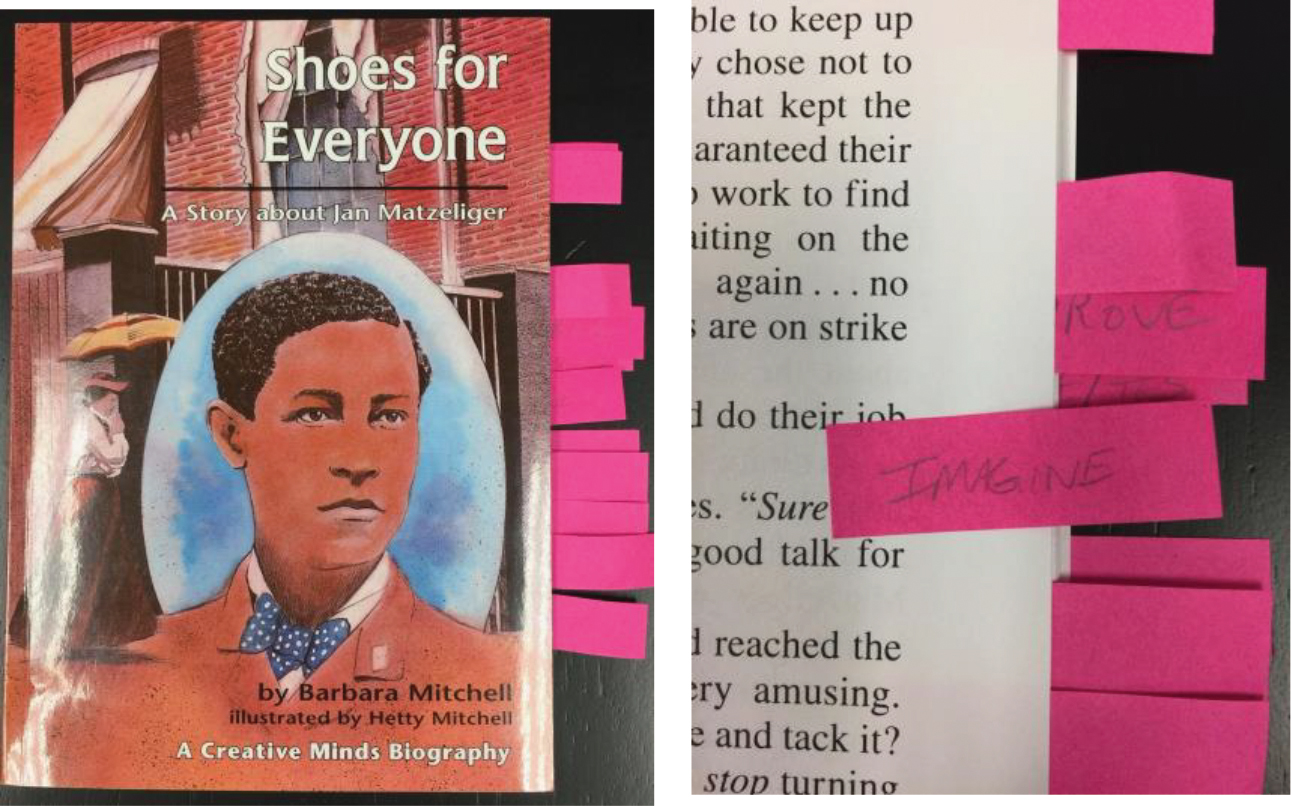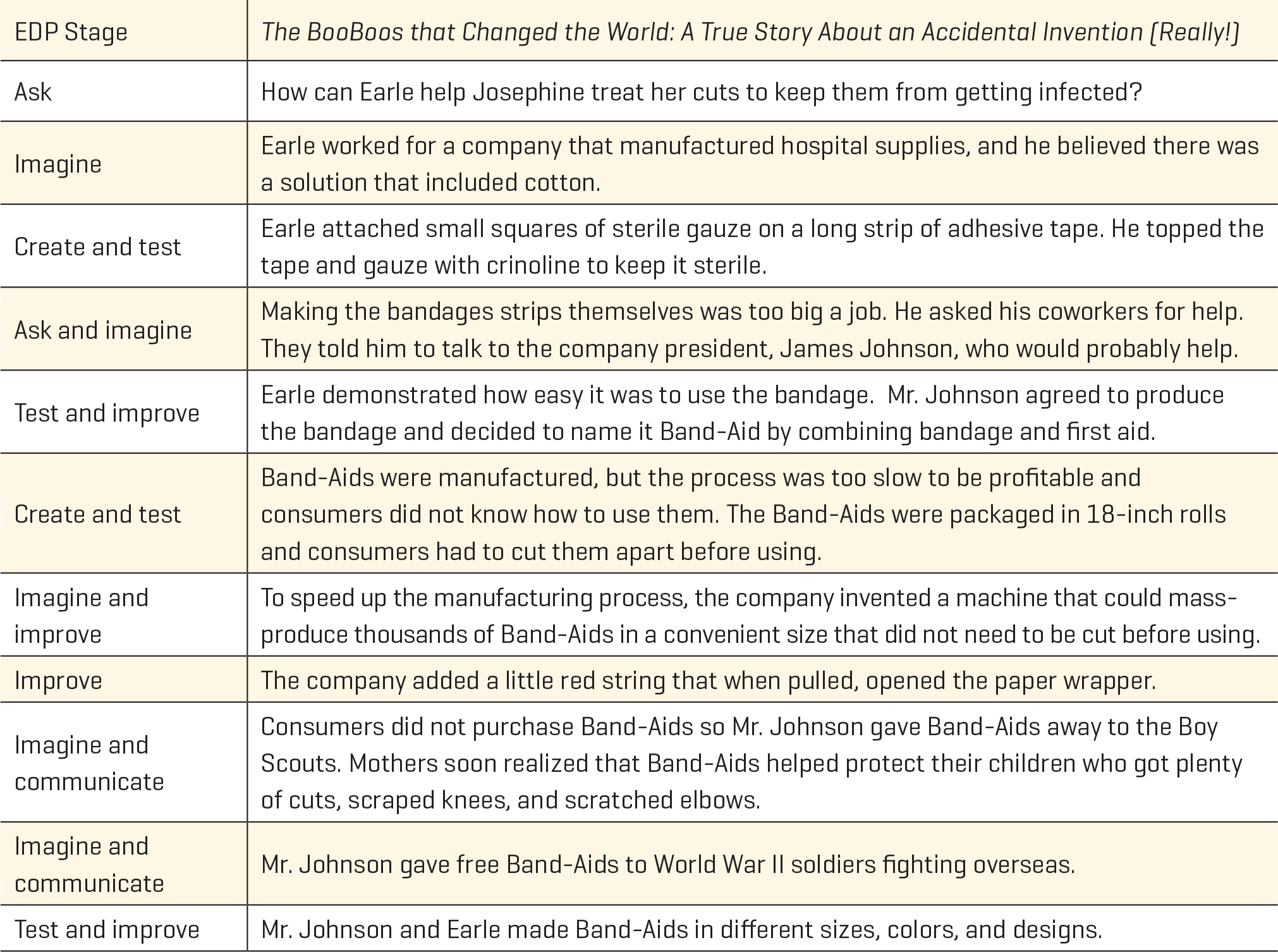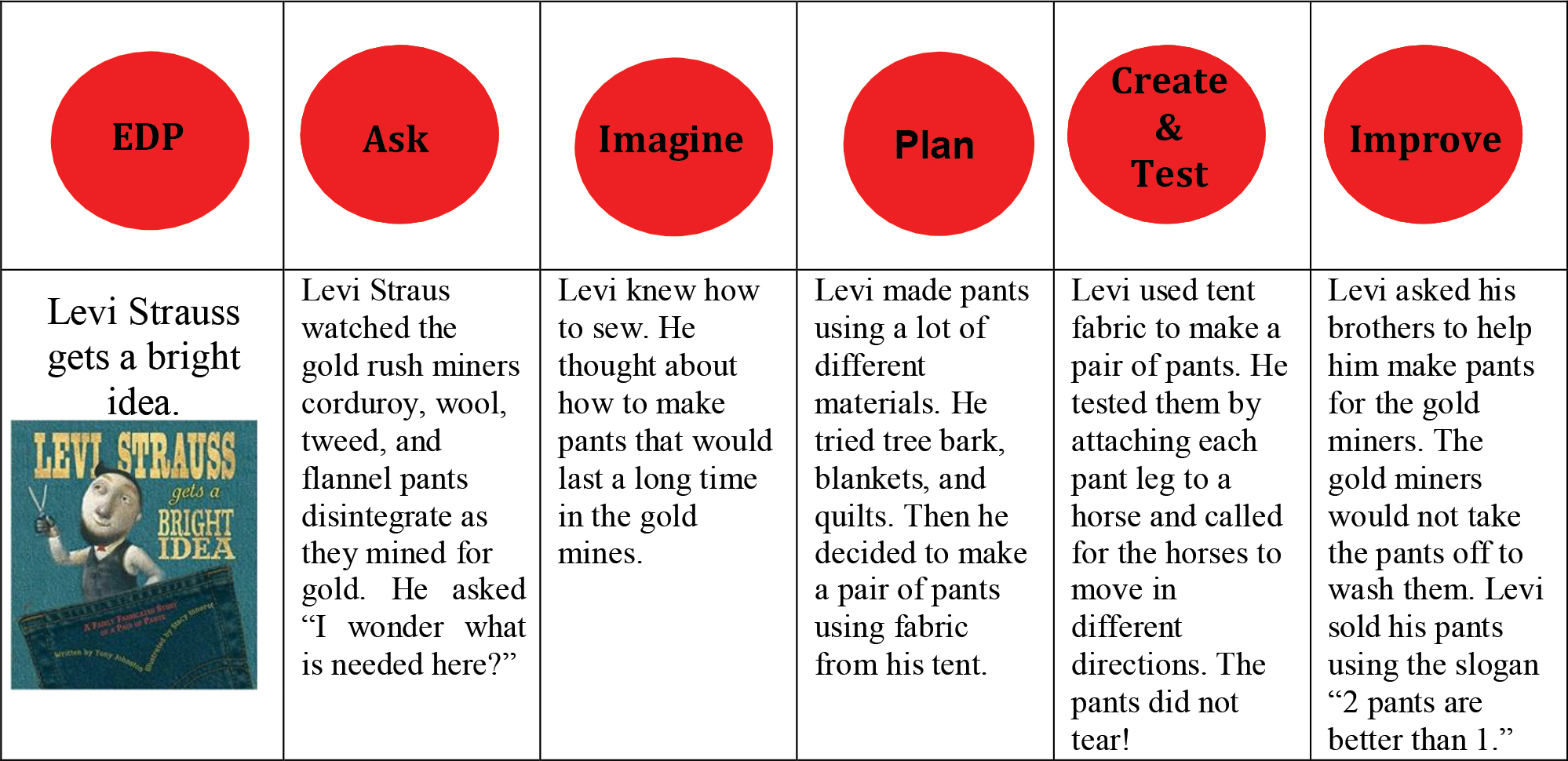feature
Using Trade Books and Biographies to Bring the Practices of Engineering to Life
As defined by A Framework for K–12 Science Education (National Research Council [NRC] 2012), engineering is “a systematic practice of design to achieve solutions to particular human problems” (p. 11). Engineers use this practice of design—often described as the engineering design process (EDP)—and their problem-solving skills to improve the human condition.
The National Academy of Engineering (NAE 2008) considers it vital students recognize that “engineers constantly discover how to improve lives by creating bold new solutions that connect science to life in unexpected ways” (p. 100). To help students better understand engineering through this lens, they propose that “stories that dramatize the rich legacy of engineering achievements” be used to help “bring the experience of engineering to life” (NAE 2008, p. 44).
Books have typically been used in STEM education to generate interest in a topic, teach content, and launch engineering design challenges. We have expanded the use of books in engineering education beyond the introduction of problems and launch of design challenges. In our classroom, biographies and trade books are instructional resources students use to understand the nature of what engineers do, to experience how engineers apply design-based thinking and the EDP to systematically and efficiently solve problems, and to investigate the accomplishments and products of engineers and inventors. Biographies are particularly good vehicles to illustrate design-based thinking because they provide a “linear, chronological sequence of events with a framework that assists readers in developing their understanding about the person and that individual’s achievements” (Werderich, Farris, and McGinty 2014, p. 66). Using these biographies, students can reverse-engineer the EDP and uncover key elements of design-based thinking for themselves.
Checklist for selecting biographies and trade books to support design-based thinking (Jackson et al., Forthcoming).
Book title:
Author:
Selected for use Yes No
|
Engineering design processes |
Yes /No |
Comments |
Page # |
|
Contains a recognizable problem |
|
|
|
|
Includes performance criteria or project goal |
|
|
|
|
Clearly outlines constraints or limitations |
|
|
|
|
Character imagines a solution |
|
|
|
|
Character conducts research or gathers ideas |
|
|
|
|
Character makes reasoned choices about materials |
|
|
|
|
Describes a design or a plan |
|
|
|
|
Character creates a prototype |
|
|
|
|
Prototype is tested and evaluated |
|
|
|
|
Describes a redesign or improvement process |
|
|
|
|
Communicates design successes and challenges with others |
|
|
|
|
Shows application of solution in daily life |
|
|
|
Selecting books for engineering lessons
Finding appropriate biographies and trade books that support design-based thinking can be a challenge. The National Science Teaching Association (NSTA) reviews hundreds of books yearly and publishes their recommendations as the Best STEM Books K–12 list (see Resources). However, many of the texts on STEM book lists include a strong problem context but lack rich detail about an engineer’s or an inventor’s thinking process. This makes using them to reverse-engineer the EDP and highlight design-based thinking problematic.
To select books that feature the complexity and creativity of engineering in action, we developed a checklist (see Figure 1) for selecting biographies and trade books that support design-based thinking. This checklist includes traditional EDP elements as well as features that support innovation and design-based thinking. We look for problem statements and plans, criteria and constraints, reasoned choices about materials, opportunities to communicate design choices, and application of the design solution in everyday life. Even detailed books will likely not address every checklist item. However, we have found that books that contain seven or more of the items are complex enough to provide a rich overview of design-based thinking (Jackson et al., Forthcoming).
As we prepare our lessons, we use sticky notes labeled with common EDP stages (problem, ask, imagine, plan create, test, redesign, communicate) and items from the checklist to mark passages and pages that include elements of design-based thinking (see Figure 2). Tracking as we read streamlines book selection and simplifies the task of remembering where specific examples of design-based thinking occurred.

Examples of sticky notes marking engineering design-based thinking processes.
Using books in engineering lessons
Once we have selected a book that includes at least seven elements from the checklist, it’s time to decide how to use the book in classroom instruction. We typically introduce design-based thinking during a whole-class activity and then allow students to more deeply explore self-selected stories of engineers independently. To initially unpack the EDP and design-based thinking, we typically read aloud either a picture book biography about an engineer or a trade book that contains an obvious problem, a plan, a prototype, testing, and improvement. As we read, we pause to connect key elements and actions in the story to the EDP and design-based thinking. The organization of the text determines the length of the reading, but each reading is usually less than 5 minutes. The complexity of how students perceive the EDP and design-based thinking builds as they re-encounter elements at different moments throughout the book (Jackson et al., Forthcoming). Although read alouds and picture books are more commonly found in elementary classrooms, they are effective for use with middle level students as well (McCormick and McTigue 2011). The strong hooks, narrative structure, vivid illustrations, and short length of picture books offer the ideal setting for an initial exploration of how engineers go about solving problems.
For example, Figure 3 outlines the progression of design-based thinking and EDP stages in the picture book The Boo-Boos That Changed the World: A True Story About an Accidental Invention (Really!) by Barry Wittenstein (2018). This book describes the problem that inspired the invention of Band-Aids as well as early prototypes, testing, improving, and early marketing efforts. Like many other biographies, this story vividly demonstrates how engineers and inventors do not follow a singular step-by-step process but rather engage in cycles of creative innovation, testing, and evaluation. It also highlights how items that are ubiquitous to students’ everyday lives were once bold new solutions that drastically improved lives when they were first invented.

The progression of design-based thinking andstages in The Boo-Boos that Changed the World: A True Story About an Accidental Invention (Really!) (Wittenstein, 2018).
|
EDP Stage |
The BooBoos that Changed the World: A True Story About an Accidental Invention (Really!) |
|
Ask |
How can Earle help Josephine treat her cuts to keep them from getting infected? |
|
Imagine |
Earle worked for a company that manufactured hospital supplies, and he believed there was a solution that included cotton. |
|
Create and test |
Earle attached small squares of sterile gauze on a long strip of adhesive tape. He topped the tape and gauze with crinoline to keep it sterile. |
|
Ask and imagine |
Making the bandages strips themselves was too big a job. He asked his coworkers for help. They told him to talk to the company president, James Johnson, who would probably help. |
|
Test and improve |
Earle demonstrated how easy it was to use the bandage. Mr. Johnson agreed to produce the bandage and decided to name it Band-Aid by combining bandage and first aid. |
|
Create and test |
Band-Aids were manufactured, but the process was too slow to be profitable and consumers did not know how to use them. The Band-Aids were packaged in 18-inch rolls and consumers had to cut them apart before using. |
|
Imagine and improve |
To speed up the manufacturing process, the company invented a machine that could mass-produce thousands of Band-Aids in a convenient size that did not need to be cut before using. |
|
Improve |
The company added a little red string that when pulled, opened the paper wrapper. |
|
Imagine and communicate |
Consumers did not purchase Band-Aids so Mr. Johnson gave Band-Aids away to the Boy Scouts. Mothers soon realized that Band-Aids helped protect their children who got plenty of cuts, scraped knees, and scratched elbows. |
|
Imagine and communicate |
Mr. Johnson gave free Band-Aids to World War II soldiers fighting overseas. |
|
Test and improve |
Mr. Johnson and Earle made Band-Aids in different sizes, colors, and designs. |
After the whole-class read aloud, students read biographies and/or trade books to find elements of design-based thinking themselves. Depending on the context, students self-select a children’s book, picture book, trade book, or chapter book biography about an engineer or an inventor from the school or community library. We also provide a curated selection of books in our classroom library from which students can make their selection. We encourage students to track elements of design-based thinking as they read their selected books. Some students choose to use sticky notes for this purpose while others create a timeline—both approaches work well. Students then use the information included in their book to complete a biography project in which they (1) identify how the main character used the EDP and design-based thinking to solve a problem and create or enhance a technology that improved lives in unexpected ways and (2) create a visual representation of this process. Finally, the students present their findings and visual aid to the class. We differentiate this activity by allowing students to select books with a wide range of reading levels and to use a variety of representational approaches. Students may also choose to work individually or in pairs.
Differentiating books in engineering lessons
We use picture book biographies and trade books with English learners and students who do not read grade-level text as these are written with simple text and include supporting illustrations that enhance comprehension. Figure 4 shows an example of how the EDP and design-based thinking can be reverse-engineered from a common picture book biography.

Picture biography and design-based thinking examples.
As we have found that many middle school students do not know the names of famous inventors or engineers, let alone those who are typically overlooked, we often provide students an initial list of names and book titles to help focus their efforts to locate appropriate biographies. For a list of picture books and trade books that we have used with middle school students who need scaffolding, see Resources. Teachers can create their own personalized list based on what is available in their physical school library or in an online library that their students can access.
We use chapter book biographies with students when reading comprehension and language are not barriers. We try to use biographies that introduce students to the reality that women and men of various social and ethnic backgrounds—and with diverse interests, talents, qualities, and motivations—can be engineers and inventors (NRC 2012). We also use books that highlight aspects of everyday life that students do not always perceive as being the domain of engineers.
Conclusion
Understanding design-based thinking is fundamental to engaging in engineering. Well-chosen biographies and trade books showcase the problem-solving processes engineers and inventors follow to create or improve technologies. They allow students to experience common elements of design-based thinking and highlight that designing and engineering are not linear processes. Rather, they are a series of complex iterative processes driven by the problem being solved, available resources, testing of prototypes, and redesign efforts. Books bring the practices of engineering to life and vividly demonstrate how we are surrounded by products—designed and created by engineers—that improve our lives.
Resources
Picture books and trade books for middle school students who need scaffolding
Julie K. Jackson (jj32@txstate.edu) is an associate professor and Michelle Forsythe is an assistant professor, both in the Department of Curriculum and Instruction at Texas State University in San Marcos.
Engineering Instructional Materials Interdisciplinary Literacy Teaching Strategies Middle School



